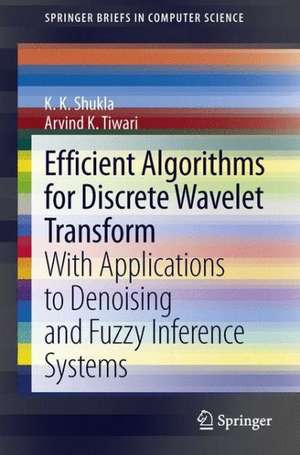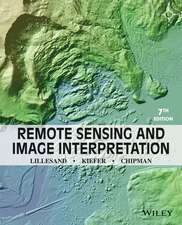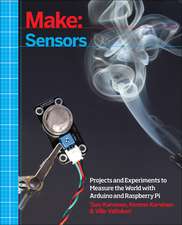Efficient Algorithms for Discrete Wavelet Transform: With Applications to Denoising and Fuzzy Inference Systems: SpringerBriefs in Computer Science
Autor K K Shukla, Arvind K. Tiwarien Limba Engleză Paperback – 7 feb 2013
Din seria SpringerBriefs in Computer Science
-
 Preț: 475.83 lei
Preț: 475.83 lei - 20%
 Preț: 166.97 lei
Preț: 166.97 lei - 20%
 Preț: 325.63 lei
Preț: 325.63 lei - 20%
 Preț: 349.15 lei
Preț: 349.15 lei - 20%
 Preț: 302.49 lei
Preț: 302.49 lei -
 Preț: 381.81 lei
Preț: 381.81 lei -
 Preț: 446.47 lei
Preț: 446.47 lei - 20%
 Preț: 296.17 lei
Preț: 296.17 lei - 20%
 Preț: 335.66 lei
Preț: 335.66 lei - 20%
 Preț: 463.83 lei
Preț: 463.83 lei - 20%
 Preț: 323.00 lei
Preț: 323.00 lei - 20%
 Preț: 322.35 lei
Preț: 322.35 lei - 20%
 Preț: 321.85 lei
Preț: 321.85 lei - 20%
 Preț: 232.68 lei
Preț: 232.68 lei -
 Preț: 375.45 lei
Preț: 375.45 lei - 20%
 Preț: 323.00 lei
Preț: 323.00 lei - 20%
 Preț: 322.81 lei
Preț: 322.81 lei - 20%
 Preț: 324.17 lei
Preț: 324.17 lei - 20%
 Preț: 323.00 lei
Preț: 323.00 lei - 20%
 Preț: 322.17 lei
Preț: 322.17 lei - 20%
 Preț: 322.50 lei
Preț: 322.50 lei - 20%
 Preț: 323.34 lei
Preț: 323.34 lei - 20%
 Preț: 324.17 lei
Preț: 324.17 lei - 20%
 Preț: 323.46 lei
Preț: 323.46 lei - 20%
 Preț: 322.17 lei
Preț: 322.17 lei - 20%
 Preț: 322.02 lei
Preț: 322.02 lei -
 Preț: 341.50 lei
Preț: 341.50 lei - 20%
 Preț: 324.49 lei
Preț: 324.49 lei -
 Preț: 344.47 lei
Preț: 344.47 lei -
 Preț: 376.80 lei
Preț: 376.80 lei -
 Preț: 377.18 lei
Preț: 377.18 lei - 20%
 Preț: 324.17 lei
Preț: 324.17 lei - 20%
 Preț: 352.26 lei
Preț: 352.26 lei - 20%
 Preț: 321.32 lei
Preț: 321.32 lei - 20%
 Preț: 322.17 lei
Preț: 322.17 lei - 20%
 Preț: 324.17 lei
Preț: 324.17 lei - 20%
 Preț: 322.02 lei
Preț: 322.02 lei -
 Preț: 374.46 lei
Preț: 374.46 lei - 20%
 Preț: 320.21 lei
Preț: 320.21 lei - 20%
 Preț: 323.34 lei
Preț: 323.34 lei - 20%
 Preț: 324.17 lei
Preț: 324.17 lei - 20%
 Preț: 231.84 lei
Preț: 231.84 lei - 20%
 Preț: 294.97 lei
Preț: 294.97 lei - 20%
 Preț: 322.50 lei
Preț: 322.50 lei - 20%
 Preț: 323.46 lei
Preț: 323.46 lei -
 Preț: 374.08 lei
Preț: 374.08 lei -
 Preț: 408.23 lei
Preț: 408.23 lei - 20%
 Preț: 321.52 lei
Preț: 321.52 lei - 20%
 Preț: 323.34 lei
Preț: 323.34 lei - 20%
 Preț: 323.00 lei
Preț: 323.00 lei
Preț: 324.64 lei
Preț vechi: 405.80 lei
-20% Nou
Puncte Express: 487
Preț estimativ în valută:
62.14€ • 67.52$ • 52.23£
62.14€ • 67.52$ • 52.23£
Carte tipărită la comandă
Livrare economică 21 aprilie-05 mai
Preluare comenzi: 021 569.72.76
Specificații
ISBN-13: 9781447149408
ISBN-10: 1447149408
Pagini: 104
Ilustrații: IX, 91 p. 46 illus., 31 illus. in color.
Dimensiuni: 155 x 235 x 5 mm
Greutate: 0.2 kg
Ediția:2013
Editura: SPRINGER LONDON
Colecția Springer
Seria SpringerBriefs in Computer Science
Locul publicării:London, United Kingdom
ISBN-10: 1447149408
Pagini: 104
Ilustrații: IX, 91 p. 46 illus., 31 illus. in color.
Dimensiuni: 155 x 235 x 5 mm
Greutate: 0.2 kg
Ediția:2013
Editura: SPRINGER LONDON
Colecția Springer
Seria SpringerBriefs in Computer Science
Locul publicării:London, United Kingdom
Public țintă
ResearchCuprins
Introduction.- Filter Banks and DWT.- Finite Precision Error Modeling and Analysis.- PVM Implementation of DWT-Based Image Denoising.- DWT-Based Power Quality Classification.- Conclusions and Future Directions.
Textul de pe ultima copertă
Transforms are an important part of an engineer’s toolkit for solving signal processing and polynomial computation problems. In contrast to the Fourier transform-based approaches where a fixed window is used uniformly for a range of frequencies, the wavelet transform uses short windows at high frequencies and long windows at low frequencies. This way, the characteristics of non-stationary disturbances can be more closely monitored. In other words, both time and frequency information can be obtained by wavelet transform. Instead of transforming a pure time description into a pure frequency description, the wavelet transform finds a good promise in a time-frequency description.
Due to its inherent time-scale locality characteristics, the discrete wavelet transform (DWT) has received considerable attention in digital signal processing (speech and image processing), communication, computer science and mathematics. Wavelet transforms are known to have excellent energy compaction characteristics and are able to provide perfect reconstruction. Therefore, they are ideal for signal/image processing. The shifting (or translation) and scaling (or dilation) are unique to wavelets. Orthogonality of wavelets with respect to dilations leads to multigrid representation.
The nature of wavelet computation forces us to carefully examine the implementation methodologies. As the computation of DWT involves filtering, an efficient filtering process is essential in DWT hardware implementation. In the multistage DWT, coefficients are calculated recursively, and in addition to the wavelet decomposition stage, extra space is required to store the intermediate coefficients. Hence, the overall performance depends significantly on the precision of the intermediate DWT coefficients.
This work presents new implementation techniques of DWT, that are efficient in terms of computation requirement, storage requirement, and with better signal-to-noiseratio in the reconstructed signal.
Due to its inherent time-scale locality characteristics, the discrete wavelet transform (DWT) has received considerable attention in digital signal processing (speech and image processing), communication, computer science and mathematics. Wavelet transforms are known to have excellent energy compaction characteristics and are able to provide perfect reconstruction. Therefore, they are ideal for signal/image processing. The shifting (or translation) and scaling (or dilation) are unique to wavelets. Orthogonality of wavelets with respect to dilations leads to multigrid representation.
The nature of wavelet computation forces us to carefully examine the implementation methodologies. As the computation of DWT involves filtering, an efficient filtering process is essential in DWT hardware implementation. In the multistage DWT, coefficients are calculated recursively, and in addition to the wavelet decomposition stage, extra space is required to store the intermediate coefficients. Hence, the overall performance depends significantly on the precision of the intermediate DWT coefficients.
This work presents new implementation techniques of DWT, that are efficient in terms of computation requirement, storage requirement, and with better signal-to-noiseratio in the reconstructed signal.
Caracteristici
Describes a mathematical model to predict the errors introduced in the implementation of the discrete wavelet transform (DWT) on fixed-point processors Explores the application of DWT on benchmark signals and images in terms of denoising Proposes a modified threshold selection and thresholding scheme Includes supplementary material: sn.pub/extras












